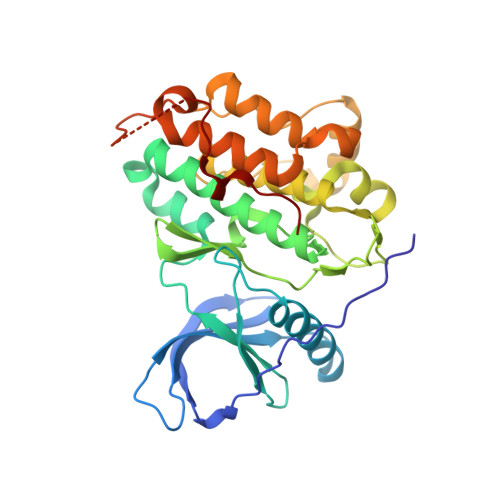Structure- and Reactivity-Based Development of Covalent Inhibitors of the Activating and Gatekeeper Mutant Forms of the Epidermal Growth Factor Receptor (EGFR).
Ward, R.A., Anderton, M.J., Ashton, S., Bethel, P.A., Box, M., Butterworth, S., Colclough, N., Chorley, C.G., Chuaqui, C., Cross, D.A., Dakin, L.A., Debreczeni, J.E., Eberlein, C., Finlay, M.R., Hill, G.B., Grist, M., Klinowska, T.C., Lane, C., Martin, S., Orme, J.P., Smith, P., Wang, F., Waring, M.J.(2013) J Med Chem 56: 7025-7048
- PubMed: 23930994
- DOI: https://doi.org/10.1021/jm400822z
- Primary Citation of Related Structures:
4LI5 - PubMed Abstract:
A novel series of small-molecule inhibitors has been developed to target the double mutant form of the epidermal growth factor receptor (EGFR) tyrosine kinase, which is resistant to treatment with gefitinib and erlotinib. Our reported compounds also show selectivity over wild-type EGFR. Guided by molecular modeling, this series was evolved to target a cysteine residue in the ATP binding site via covalent bond formation and demonstrates high levels of activity in cellular models of the double mutant form of EGFR. In addition, these compounds show significant activity against the activating mutations, which gefitinib and erlotinib target and inhibition of which gives rise to their observed clinical efficacy. A glutathione (GSH)-based assay was used to measure thiol reactivity toward the electrophilic functionality of the inhibitor series, enabling both the identification of a suitable reactivity window for their potency and the development of a reactivity quantitative structure-property relationship (QSPR) to support design.
Organizational Affiliation:
AstraZeneca , Oncology & Discovery Sciences Innovative Medicines, Mereside, Alderley Park, Macclesfield, Cheshire SK10 4TG, United Kingdom.
















